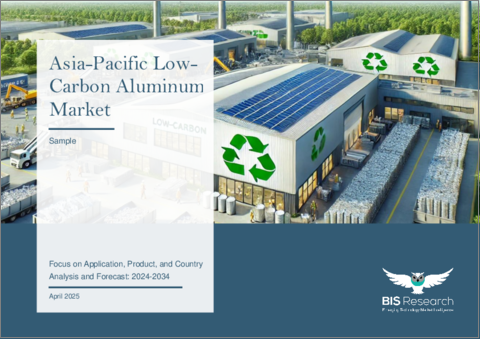|
|
市場調査レポート
商品コード
1700011
アジア太平洋の低炭素アルミニウム市場:用途別、製品別、国別 - 分析と予測(2024年~2034年)Asia-Pacific Low-Carbon Aluminum Market: Focus on Application, Product, and Country - Analysis and Forecast, 2024-2034 |
||||||
カスタマイズ可能
|
|||||||
| アジア太平洋の低炭素アルミニウム市場:用途別、製品別、国別 - 分析と予測(2024年~2034年) |
|
出版日: 2025年04月10日
発行: BIS Research
ページ情報: 英文 85 Pages
納期: 1~5営業日
|
- 全表示
- 概要
- 図表
- 目次
アジア太平洋の低炭素アルミニウムの市場規模は、2024年の341億7,000万米ドルから2034年には616億3,000万米ドルに達し、予測期間の2024年~2034年のCAGRは6.08%になると予測されています。
低炭素アルミニウムの需要増は、軽量素材を利用する電気自動車の人気の高まりが牽引しています。様々な分野の中でも、自動車産業は脱炭素化への取り組みが顕著で、低炭素アルミニウムの普及につながっています。政府の規制は、低炭素アルミニウムの使用をさらに奨励し、自動車の軽量化に役立つため、燃費効率が向上します。さらに、低炭素アルミニウムはCO2排出量の削減にも貢献するため、自動車用途では環境に優しい選択肢となっています。
| 主要市場統計 | |
|---|---|
| 予測期間 | 2024年~2034年 |
| 2024年の評価額 | 341億7,000万米ドル |
| 2034年の予測 | 616億3,000万米ドル |
| CAGR | 6.08% |
アジア太平洋における低炭素アルミニウムの需要拡大を促進する重要な要因は、持続可能で軽量な材料の使用を重視する電気自動車(EV)セクターの急成長です。電動モビリティは、中国、日本、韓国、インドといった国々の持続可能性課題における重要な要素であり、これらの国々は輸送業界の脱炭素化への取り組みを強化しています。アジア太平洋の自動車産業は、エネルギー効率を高め、厳しい排出要件を満たすことに重点を置いているため、他の最終用途産業の中でも低炭素アルミニウム採用の重要な原動力として際立っています。
同地域の政府は、自動車生産において環境に優しい材料の使用を奨励する法律やインセンティブを整備しています。低炭素アルミニウムの需要は、中国の二重クレジット政策やインドのFAME(Faster Adoption and Manufacturing of Hybrid and Electric Vehicles)プログラムのような、自動車メーカーに低排出技術の使用を奨励する政策によって間接的に促進されています。この材料は、ライフサイクルのCO2排出量を削減するという全体的な目的に加え、バッテリー航続距離と燃費を向上させる車両重量の大幅な削減にも役立ちます。
さらに、気候変動に対するアジア太平洋の意識の高まりとネットゼロ目標達成へのコミットメントが、国内外の自動車メーカーに環境に優しい原材料の調達を促しています。その結果、持続可能性に対する規制と消費者の期待の両方を満たすことを目指す自動車メーカーにとって、低炭素アルミニウムは好ましい選択肢となりつつあります。同地域の大規模な工業生産能力とグリーン製造技術への投資は、低炭素アルミニウムの主要市場としての地位を今後さらに強固なものにしていくと思われます。
アジア太平洋の低炭素アルミニウム市場は、環境意識の高まり、産業界の脱炭素化への取り組み、環境に優しい生産方法の増加により急速に拡大しています。中国、日本、韓国、インドなどの国々で厳しい排出規制が実施された結果、環境に優しい素材へのニーズが高まっています。低炭素アルミニウムは、カーボンフットプリントが低く、リサイクルが可能であるため、エレクトロニクス、包装、建築、自動車産業などの重要な分野で人気が高まっています。技術開発とクリーンエネルギー源への計算された投資により、この地域は、政府と企業がネットゼロ目標を目指す中で、環境に優しいアルミニウム生産の主な中心地として台頭しつつあります。
産業界における脱炭素化への取り組みと政府規制の高まりが、アジア太平洋の低炭素アルミニウム市場を牽引しています。エレクトロニクス、建設、自動車産業からの需要増加が成長を加速させ、再生可能エネルギーによる製錬・リサイクル技術の進歩も拡大を促進しています。主な発展には、持続可能な生産能力の拡大、環境に優しい方法への多額の投資、主要なパートナーシップなどがあります。強力な法律、環境に優しい製品に対する消費者の需要、ネット・ゼロ・エミッションを達成するための国際的な誓約が、市場を牽引する主な要因です。とはいえ、法外な生産価格、再生可能エネルギーへのアクセス制限、不明確な規制、サプライチェーンの中断などの障害は、依然として着実な市場の持続可能性と急成長の妨げとなっています。これらは、今後も業界の重要な障害であり続けます。
製品セグメントは、読者が低炭素アルミニウム市場に関わるさまざまな生産源と製品を理解するのに役立ちます。生産源セグメントは、太陽エネルギー、風力エネルギー、水力エネルギー、リサイクル、炭素回収・貯留(CCS)、その他に区分されています。さらに、輸送、建築・建設、電気産業、消費財、ホイル・包装、機械・設備などのエンドユーザーに基づく低炭素アルミニウム市場の詳細な理解を読者に提供します。持続可能な技術における製造部品への低炭素アルミニウムの採用の増加は、市場の成長を促進すると予想されます。
アジア太平洋の低炭素アルミニウム市場は、事業拡大、パートナーシップ、提携、M&A、合弁事業など、市場で事業を展開する主要企業による主要な開拓が見られます。各社が好んでとる戦略は、低炭素アルミニウム市場での地位を強化するための事業拡大です。
アジア太平洋の低炭素アルミ市場の主要企業には、低炭素アルミメーカーやエコシステム全体が含まれます。さらに、低炭素アルミニウム市場で活動する参入企業の詳細な競合ベンチマーキングは、読者が明確な市場情勢を提示し、参入企業が互いにどのようにスタックしているかを理解するのに役立っています。さらに、パートナーシップ、契約、買収、提携などの包括的な競合戦略は、読者が市場の未開拓の収益ポケットを理解するのに役立ちます。
当レポートでは、アジア太平洋の低炭素アルミニウム市場について調査し、市場の概要とともに、用途別、製品別、国別の動向、および市場に参入する企業のプロファイルなどを提供しています。
目次
エグゼクティブサマリー
第1章 市場:業界展望
- 動向:現状と将来への影響評価
- 低炭素アルミニウムへの投資増加
- 低炭素インフラ整備に向けた政府の取り組み
- サプライチェーンの概要
- 低炭素アルミニウム市場のエコシステム
- 市場力学の概要
- スタートアップの情勢
- 特許分析
- アルミニウム生産における炭素排出
- 貿易分析:アルミニウム、2021年~2023年
- 2023年における主要な稼働アルミニウム工場
第2章 地域
- 地域サマリー
- アジア太平洋
- 地域概要
- 市場成長促進要因
- 市場成長抑制要因
- 中国
- 日本
- インド
- 韓国
- ASEAN
- その他
第3章 市場-競合ベンチマーキングと企業プロファイル
- 今後の見通し
- 地理的評価
- Vedanta Aluminium & Power
- China Hongqiao Group Limited
- Capral Limited
- Runaya
- South32
- PT Indonesia Asahan Aluminium
第4章 調査手法
List of Figures
- Figure 1: Asia-Pacific Low-Carbon Aluminum Market (by Scenario), $Billion, 2024, 2028, and 2034
- Figure 2: Low-Carbon Aluminum Market (by Region), $Billion, 2023, 2028, and 2034
- Figure 3: Asia-Pacific Low-Carbon Aluminum Market (by End User), $Billion, 2023, 2028, and 2034
- Figure 4: Asia-Pacific Low-Carbon Aluminum Market (by Production Pathway at Smelter Level), $Billion, 2023, 2028, and 2034
- Figure 5: Key Events
- Figure 6: Impact Analysis of Low-Carbon Aluminum Market Navigating Factors, 2024-2034
- Figure 7: Process-Wise Greenhouse Gas Emissions, Tons of Carbon Dioxide per Ton of Primary Aluminum Produced, 2023
- Figure 8: Patent Analysis (by Year), January 2021-December 2024
- Figure 9: Patent Analysis (by Country), January 2021-December 2024
- Figure 10: Aluminum Trade Analysis - Net Trade (by Region), $Billion, 2021-2023
- Figure 11: Aluminum Trade Analysis - Net Trade (by Region), $Billion, 2021-2023
- Figure 12: China Low-Carbon Aluminum Market, $Billion, 2023-2034
- Figure 13: Japan Low-Carbon Aluminum Market, $Billion, 2023-2034
- Figure 14: India Low-Carbon Aluminum Market, $Billion, 2023-2034
- Figure 15: South Korea Low-Carbon Aluminum Market, $Billion, 2023-2034
- Figure 16: ASEAN Low-Carbon Aluminum Market, $Billion, 2023-2034
- Figure 17: Rest-of-Asia-Pacific Low-Carbon Aluminum Market, $Billion, 2023-2034
- Figure 18: Strategic Initiatives, January 2021-December 2024
- Figure 19: Data Triangulation
- Figure 20: Top-Down and Bottom-Up Approach
- Figure 21: Assumptions and Limitations
List of Tables
- Table 1: Market Snapshot
- Table 2: Opportunities across Regions
- Table 3: Recent Government Activities toward Low-Carbon Infrastructure
- Table 4: Regulatory/Certification Bodies in Low-Carbon Aluminum Market
- Table 5: Recent Government Programs in Low-Carbon Aluminum Market
- Table 6: Key Research Institutes and University Programs in Low-Carbon Aluminum Market
- Table 7: Recent R&D Initiatives in Low-Carbon Aluminum Market
- Table 8: Start-ups and Investment Landscape
- Table 9: Greenhouse Gas Emissions Intensity - Primary Aluminum, Tons of CO2e per Ton of Primary Aluminum, 2023
- Table 10: Greenhouse Gas Emissions - Aluminum Sector, Overall CO2 Emissions, Million Tons of CO2e, 2023
- Table 11: List of Key Operating Aluminum Plants, 2023
- Table 12: Low-Carbon Aluminum Market (by Region), $Billion, 2023-2034
- Table 13: Asia-Pacific Low-Carbon Aluminum Market (by End User), $Billion, 2023-2034
- Table 14: Asia-Pacific Low-Carbon Aluminum Market (by Production Pathway at Smelter Level), $Billion, 2023-2034
- Table 15: China Low-Carbon Aluminum Market (by End User), $Billion, 2023-2034
- Table 16: China Low-Carbon Aluminum Market (by Production Pathway at Smelter Level), $Billion, 2023-2034
- Table 17: Japan Low-Carbon Aluminum Market (by End User), $Billion, 2023-2034
- Table 18: Japan Low-Carbon Aluminum Market (by Production Pathway at Smelter Level), $Billion, 2023-2034
- Table 19: India Low-Carbon Aluminum Market (by End User), $Billion, 2023-2034
- Table 20: India Low-Carbon Aluminum Market (by Production Pathway at Smelter Level), $Billion, 2023-2034
- Table 21: South Korea Low-Carbon Aluminum Market (by End User), $Billion, 2023-2034
- Table 22: South Korea Low-Carbon Aluminum Market (by Production Pathway at Smelter Level), $Billion, 2023-2034
- Table 23: ASEAN Low-Carbon Aluminum Market (by End User), $Billion, 2023-2034
- Table 24: ASEAN Low-Carbon Aluminum Market (by Production Pathway at Smelter Level), $Billion, 2023-2034
- Table 25: Rest-of-Asia-Pacific Low-Carbon Aluminum Market (by End User), $Billion, 2023-2034
- Table 26: Rest-of-Asia-Pacific Low-Carbon Aluminum Market (by Production Pathway at Smelter Level), $Billion, 2023-2034
- Table 27: Market Share, 2023
Introduction to Asia-Pacific Low-Carbon Aluminum Market
The Asia-Pacific low-carbon aluminum market is projected to reach $61.63 billion by 2034 from $34.17 billion in 2024, growing at a CAGR of 6.08% during the forecast period 2024-2034. The growing demand for low-carbon aluminum is being driven by the rising popularity of electric vehicles, which utilize lightweight materials. Among various sectors, the automotive industry stands out for its significant efforts toward decarbonization, leading to widespread adoption of low-carbon aluminum. Government regulations further incentivize the use of low-carbon aluminum, as it aids in reducing vehicle weight, thereby enhancing fuel efficiency. Additionally, low-carbon aluminum contributes to reducing CO2 emissions, making it an environmentally friendly choice for automotive applications.
Market Introduction
| KEY MARKET STATISTICS | |
|---|---|
| Forecast Period | 2024 - 2034 |
| 2024 Evaluation | $34.17 Billion |
| 2034 Forecast | $61.63 Billion |
| CAGR | 6.08% |
An important factor driving the growing demand for low-carbon aluminium in the Asia-Pacific (APAC) region is the burgeoning electric vehicle (EV) sector, which places a strong emphasis on the use of sustainable and lightweight materials. Electric mobility is a key component of the sustainability agendas of nations like China, Japan, South Korea, and India, which are stepping up their efforts to decarbonise the transportation industry. Because of its emphasis on increasing energy efficiency and fulfilling strict emission requirements, the automobile industry in Asia-Pacific stands out among other end-use industries as a significant driver of the adoption of low-carbon aluminium.
The region's governments are putting laws and incentives into place to encourage the use of environmentally friendly materials in the production of automobiles. The demand for low-carbon aluminium is being indirectly fuelled by policies such as China's dual credit policy and India's Faster Adoption and Manufacturing of Hybrid and Electric Vehicles (FAME) program, which encourage automakers to use low-emission technologies. This material aids the overall objective of lowering lifecycle CO2 emissions in addition to greatly reducing vehicle weight, which enhances battery range and fuel efficiency.
Furthermore, APAC's growing awareness of climate change and its commitment to achieving net-zero targets are prompting both domestic and international automotive manufacturers to source greener raw materials. As a result, low-carbon aluminum is becoming a preferred choice for automakers aiming to meet both regulatory and consumer expectations for sustainability. The region's large-scale industrial capacity and investments in green manufacturing technologies further strengthen its position as a key market for low-carbon aluminum in the years to come.
The market for low-carbon aluminium in Asia-Pacific is expanding rapidly due to rising environmental consciousness, industry decarbonisation initiatives, and an increase in environmentally friendly production methods. The need for environmentally friendly materials is growing as a result of tougher emissions laws being implemented in nations like China, Japan, South Korea, and India. Because of its lower carbon footprint and ability to be recycled, low-carbon aluminium is becoming more and more popular in important sectors including electronics, packaging, construction, and the automobile industry. With the help of technology developments and calculated investments in clean energy sources, the area is emerging as a key centre for environmentally friendly aluminium production as governments and businesses strive for net-zero goals.
Market Segmentation
Segmentation 1: by End-User
- Transportation
- Building and Construction
- Electrical Industry
- Consumer Goods
- Foil and Packaging
- Machinery and Equipment
- Others
Segmentation 2: by Production Pathway at Smelter Level
- Primary Aluminum Production
- Renewable-Powered Electrolysis (Traditional Hall-Heroult Process with Renewable Energy)
Solar Energy
Wind Energy
Hydro Energy
Hydrogen Powered Electrolysis
- CCUS Integration to Reduce Process Emissions
- Inert Anode Technology
- Drained Cathode Cell
- Recycled or Secondary Aluminum Production
Segmentation 3: by Country
- China
- Japan
- India
- South Korea
- ASEAN
- Rest-of-Asia-Pacific
Market Trends, Drives and Challenges of APAC Low-Carbon Aluminum Market
Growing industrial decarbonisation initiatives and government regulations are driving the APAC low-carbon aluminium market. Rising demand from the electronics, construction, and automotive industries has accelerated growth, while advancements in smelting and recycling technologies driven by renewable energy have also fuelled expansion. Important developments include growing sustainable production capacity, significant investments in environmentally friendly methods, and key partnerships. Strong laws, consumer demand for eco-friendly products, and international pledges to achieve net-zero emissions are the main factors driving the market. Nevertheless, obstacles including exorbitant production prices, restricted access to renewable energy, unclear regulations, and supply chain interruptions still impede steady market sustainability and quick growth. They continue to be important industry obstacles.
How can this report add value to an organization?
Product/Innovation Strategy: The product segment helps the reader understand the different sources of production and products involved in the low-carbon aluminum market. The source of production segment has been segmented into solar energy, wind energy, hydro energy, recycling, carbon capture and storage (CCS), and others. Moreover, the study provides the reader with a detailed understanding of the low-carbon aluminum market based on end users, including transportation, building and construction, the electrical industry, consumer goods, foil and packaging, machinery and equipment, and others. The increasing adoption of low-carbon aluminum in manufacturing components in sustainable technologies is expected to fuel the growth of the market.
Growth/Marketing Strategy: The APAC low-carbon aluminum market has seen major development by key players operating in the market, such as business expansions, partnerships, collaborations, mergers and acquisitions, and joint ventures. The favored strategy for the companies has been business expansions to strengthen their position in the low-carbon aluminum market.
Competitive Strategy: Key players in the APAC low-carbon aluminum market analyzed and profiled in the study involve low-carbon aluminum producers and the overall ecosystem. Moreover, a detailed competitive benchmarking of the players operating in the low-carbon aluminum market has been done to help the reader understand how players stack against each other, presenting a clear market landscape. Additionally, comprehensive competitive strategies such as partnerships, agreements, acquisitions, and collaborations will aid the reader in understanding the untapped revenue pockets in the market.
Key Market Players and Competition Synopsis
The companies that are profiled in the Asia-Pacific low-carbon aluminum market have been selected based on input gathered from primary experts and analyzing company coverage, project portfolio, and market penetration.
Some of the prominent companies in this market are:
- Vedanta Aluminium & Power
- China Hongqiao Group Limited
- Capral Limited
- Runaya
- South32
- PT Indonesia Asahan Aluminium
Table of Contents
Executive Summary
Scope and Definition
1 Market: Industry Outlook
- 1.1 Trends: Current and Future Impact Assessment
- 1.1.1 Increasing Investments in Low-Carbon Aluminum
- 1.1.2 Government Activities Toward the Establishment of Low-Carbon Infrastructure
- 1.2 Supply Chain Overview
- 1.3 Ecosystem of the Low-Carbon Aluminum Market
- 1.3.1 Regulatory/Certification Bodies
- 1.3.2 Government Programs
- 1.3.3 Programs by Research Institutions and Universities
- 1.4 Market Dynamics Overview
- 1.4.1 Market Drivers
- 1.4.1.1 Increasing Attention of Governments toward Decarbonization of Core Contributing Commodities
- 1.4.1.2 Growing Research and Development Activities to Achieve Near Zero Emissions
- 1.4.2 Market Challenges
- 1.4.2.1 Lower Recycling Rates for Aluminum in Various Industries
- 1.4.2.2 Volatile Low-Carbon Aluminum Prices
- 1.4.3 Business Strategies
- 1.4.3.1 Product Developments
- 1.4.3.2 Market Developments
- 1.4.4 Corporate Strategies
- 1.4.4.1 Partnerships and Joint Ventures
- 1.4.5 Market Opportunities
- 1.4.5.1 Low-Carbon Aluminum in Niche Segments such as Ultra-Low-CO2 Grades
- 1.4.5.2 Climate Mitigation Initiatives to Increase Demand for Sustainably Sourced Aluminum
- 1.4.1 Market Drivers
- 1.5 Start-Ups Landscape
- 1.5.1 Key Start-Ups in the Ecosystem
- 1.6 Patent Analysis
- 1.6.1 Patent Filing Trend (by Number of Patents, by Year and by Country)
- 1.7 Embedded Carbon Emissions in Aluminum Production
- 1.8 Trade Analysis: Aluminum, 2021-2023
- 1.9 Key Operating Aluminum Plants, 2023
2 Region
- 2.1 Regional Summary
- 2.2 Asia-Pacific
- 2.2.1 Regional Overview
- 2.2.2 Driving Factors for Market Growth
- 2.2.3 Factors Challenging the Market
- 2.2.3.1 Application
- 2.2.3.2 Product
- 2.2.4 China
- 2.2.4.1 Application
- 2.2.4.2 Product
- 2.2.5 Japan
- 2.2.5.1 Application
- 2.2.5.2 Product
- 2.2.6 India
- 2.2.6.1 Application
- 2.2.6.2 Product
- 2.2.7 South Korea
- 2.2.7.1 Application
- 2.2.7.2 Product
- 2.2.8 ASEAN
- 2.2.8.1 Application
- 2.2.8.2 Product
- 2.2.9 Rest-of-Asia-Pacific
- 2.2.9.1 Application
- 2.2.9.2 Product
3 Markets - Competitive Benchmarking & Company Profiles
- 3.1 Next Frontiers
- 3.2 Geographic Assessment
- 3.2.1 Vedanta Aluminium & Power
- 3.2.1.1 Overview
- 3.2.1.2 Top Competitors
- 3.2.1.3 Top Products/Product Portfolio
- 3.2.1.4 Target Customers/End-Use Industries
- 3.2.1.5 Key Personnel
- 3.2.1.6 Analyst View
- 3.2.1.7 Market Share, 2023
- 3.2.2 China Hongqiao Group Limited
- 3.2.2.1 Overview
- 3.2.2.2 Top Competitors
- 3.2.2.3 Top Products/Product Portfolio
- 3.2.2.4 Target Customers/End-Use Industries
- 3.2.2.5 Key Personnel
- 3.2.2.6 Analyst View
- 3.2.2.7 Market Share, 2023
- 3.2.3 Capral Limited
- 3.2.3.1 Overview
- 3.2.3.2 Top Competitors
- 3.2.3.3 Top Products/Product Portfolio
- 3.2.3.4 Target Customers/End-Use Industries
- 3.2.3.5 Key Personnel
- 3.2.3.6 Analyst View
- 3.2.3.7 Market Share, 2023
- 3.2.4 Runaya
- 3.2.4.1 Overview
- 3.2.4.2 Top Competitors
- 3.2.4.3 Top Products/Product Portfolio
- 3.2.4.4 Target Customers/End-Use Industries
- 3.2.4.5 Key Personnel
- 3.2.4.6 Analyst View
- 3.2.4.7 Market Share, 2023
- 3.2.5 South32
- 3.2.5.1 Overview
- 3.2.5.2 Top Competitors
- 3.2.5.3 Top Products/Product Portfolio
- 3.2.5.4 Target Customers/End-Use Industries
- 3.2.5.5 Key Personnel
- 3.2.5.6 Analyst View
- 3.2.5.7 Market Share, 2023
- 3.2.6 PT Indonesia Asahan Aluminium
- 3.2.6.1 Overview
- 3.2.6.2 Top Competitors
- 3.2.6.3 Top Products/Product Portfolio
- 3.2.6.4 Target Customers/End-Use Industries
- 3.2.6.5 Key Personnel
- 3.2.6.6 Analyst View
- 3.2.6.7 Market Share, 2023
- 3.2.1 Vedanta Aluminium & Power
4 Research Methodology
- 4.1 Data Sources
- 4.1.1 Primary Data Sources
- 4.1.2 Secondary Data Sources
- 4.1.3 Data Triangulation
- 4.2 Market Estimation and Forecast






